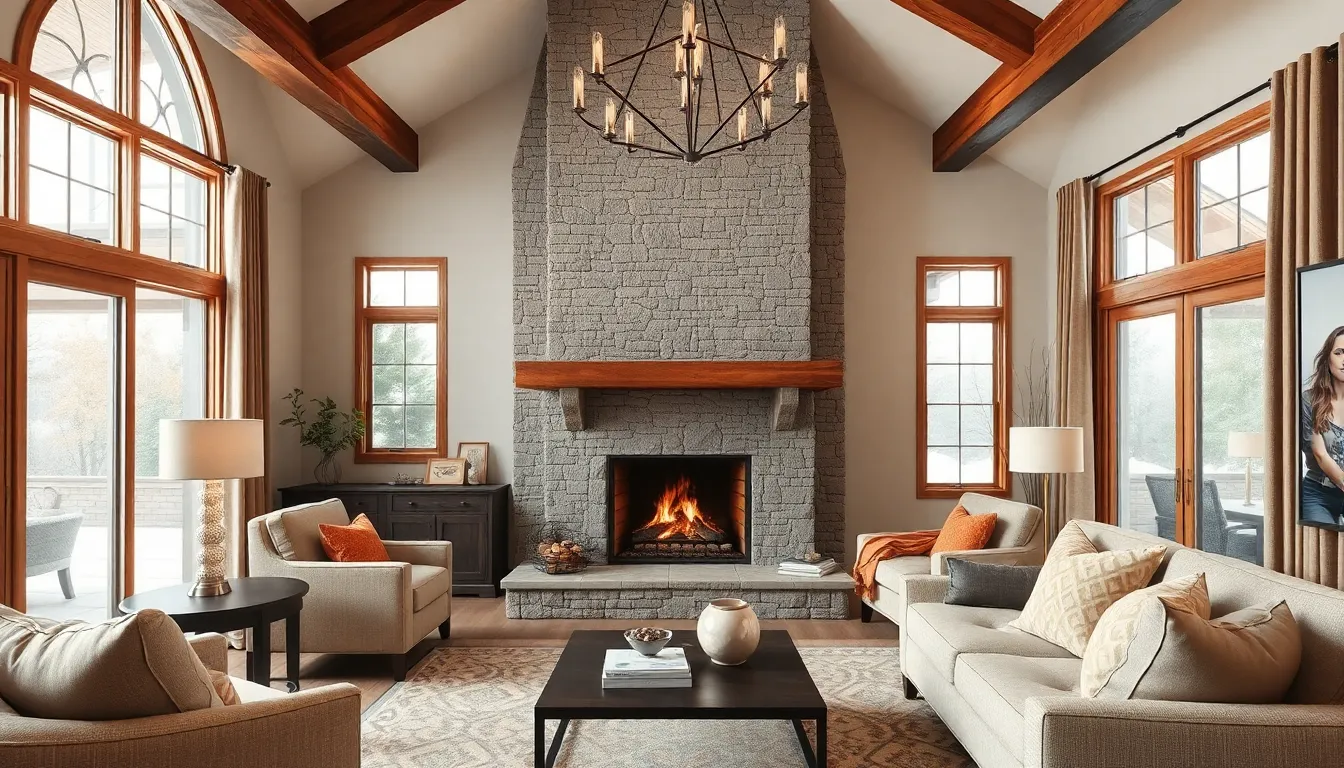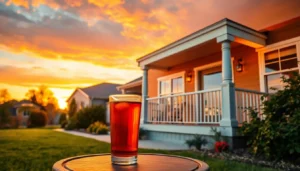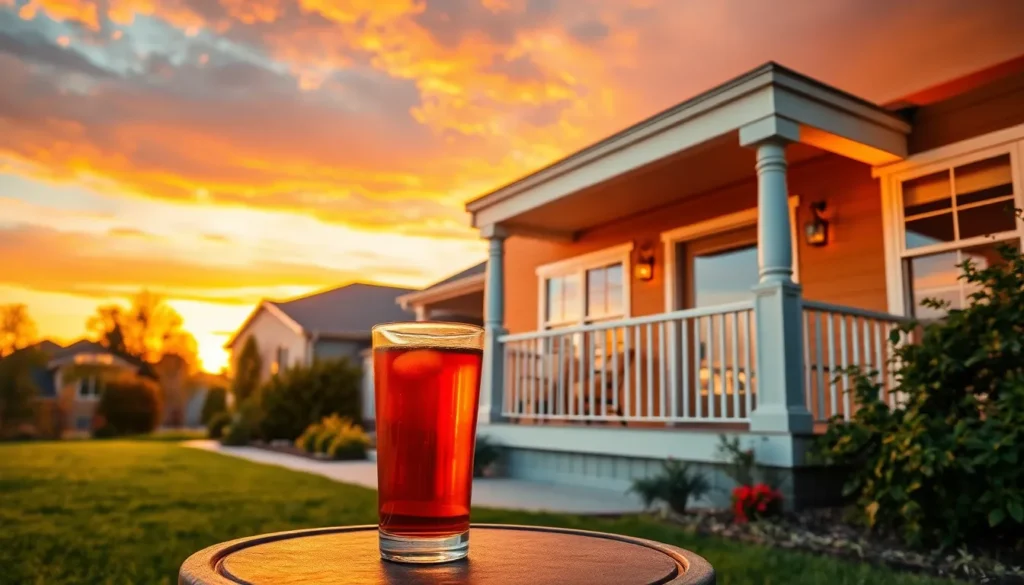Table of Contents
ToggleImagine cozying up on a chilly evening, wrapped in a blanket, with the warm glow of a fireplace flickering in front of you. A well-designed fireplace doesn’t just heat a room; it transforms it into a sanctuary. Whether it’s a sleek modern masterpiece or a rustic, timeworn charm, the right fireplace can be the heart of any home.
Overview Of Fireplace Design
Fireplace design plays a crucial role in enhancing the aesthetic and functional qualities of a home. A fireplace not only provides warmth but also serves as a focal point, transforming spaces with its presence.
History Of Fireplace Design
Fireplace design has a rich history that dates back thousands of years. Early hearths were simple structures made of stone or clay, primarily serving the purpose of warmth and cooking. As civilizations advanced, so did fireplace aesthetics, incorporating decorative elements and more efficient designs. The Renaissance period marked significant changes, with ornate mantels and detailed craftsmanship gaining popularity. Innovations continued into the 18th and 19th centuries, bringing cast iron and stylish enclosures that catered to varying architectural styles.
Evolution Of Styles
Fireplace styles have evolved significantly through the decades. Traditional designs often feature ornate moldings and intricate brickwork, providing a classic look. In contrast, modern fireplaces embrace minimalism, incorporating sleek materials like glass and steel. Rustic designs draw inspiration from nature, using natural stones and reclaimed wood for an earthy feel. Mid-century modern fireplaces showcase innovative forms, offering a balance between form and function. These diverse styles allow homeowners to select a fireplace that complements their overall decor, ensuring a personalized touch in every space.
Popular Fireplace Design Styles

Fireplaces come in a range of designs, each with its unique charm and function. Homeowners can select from various styles, from modern to rustic, to align with their specific decor themes.
Modern Fireplace Designs
Contemporary spaces often feature modern fireplace designs that prioritize sleek lines and minimalism. These designs typically incorporate materials like glass, steel, and concrete, creating a sophisticated look. Some options offer wall-mounted features that provide a floating effect. Electric fireplaces frequently fit into this category, offering flexibility and easy installation. Many modern designs boast innovative technology, including smart controls for an enhanced user experience.
Traditional Fireplace Designs
Traditional fireplace designs evoke classic elegance with their detailed craftsmanship. Brick and stone materials frequently enhance these designs, showcasing timeless appeal. Mantels often feature intricate woodwork or decorative stone elements, serving as focal points in the room. Wood-burning fireplaces commonly fall into this category, providing warmth and a nostalgic ambiance. Many traditional designs reflect architectural styles, such as Colonial or Victorian, promoting a rich historical connection.
Rustic Fireplace Designs
Rustic fireplace designs draw inspiration from nature, exuding warmth and comfort. Wood beams and natural stone typically form the foundation of these designs, integrating rustic charm. Such options often utilize reclaimed materials, reinforcing the eco-friendly aspect of design. Fireplaces may include oversized mantels crafted from rough-hewn timber, creating an inviting atmosphere. Many rustic styles complement country or lodge-themed interiors, enhancing the overall coziness of living spaces.
Materials Used In Fireplace Design
Fireplace design incorporates various materials, each contributing to the aesthetic and functional aspects of the space. The selection of materials significantly impacts the overall style and atmosphere.
Brick And Stone
Brick and stone serve as timeless materials for fireplace designs. Both options provide durability and a classic look, making them popular choices for traditional and rustic styles. Solid brick fireplaces offer a warm, inviting feel, while natural stone adds an earthy texture and sophisticated touch. These materials also excel in heat retention, enhancing the fireplace’s efficiency. Whether choosing a rugged stone facade or a smoothly finished brick face, the options allow for versatility in design.
Metal And Glass
Metal and glass introduce sleekness to fireplace designs. Steel and wrought iron frequently showcase modern aesthetics, highlighting clean lines and minimalism. Glass fronts enhance safety while providing a clear view of the flames. Using metal accents can create striking contrast with more traditional materials, allowing for innovative designs. Choices like stainless steel or brass deliver contemporary flair, and glass ensures a seamless connection between the fire and the room.
Tile And Concrete
Tile and concrete offer a unique twist on fireplace materials. These elements bring bold color and texture to the design, allowing for creative expression. Ceramic tiles provide endless patterns and finishes, enabling personalization in style. Meanwhile, concrete offers a modern, industrial look, often used for both structural and decorative elements. A fireplace with tiled embellishments or a sleek concrete finish can serve as a striking focal point, balancing form and function in contemporary living spaces.
Tips For Choosing The Right Fireplace Design
Choosing the right fireplace design involves careful consideration of several key factors to ensure it complements a home’s overall aesthetic and functional needs.
Assessing Your Space
Evaluate the size of the room first. A large room often requires a statement fireplace to create balance. Take into account the ceiling height as well. High ceilings benefit from tall, grand designs that draw the eye upward. Conversely, smaller spaces can accommodate more compact options. Check for architectural elements like windows and doors, which may influence placement. Measurements matter, so always ensure the fireplace fits snugly within its designated area.
Considering Heat Output
Analyze your heating needs. Different fireplace designs provide varying levels of heat output. Gas and electric models typically offer efficient heating solutions with adjustable settings. Traditional wood-burning fireplaces create ambiance but may require more maintenance. Calculate the square footage of the space to determine the appropriate BTU rating for effective heating. It’s essential to match the fireplace’s heat output with the room size to achieve optimal comfort.
Style Compatibility
Assess the existing decor style next. Modern spaces might benefit from minimalist designs featuring sleek lines, while traditional homes often pair well with ornate, classic looks. Balance the fireplace design with color palettes and materials already present in the room. Rustic settings call for natural stone or reclaimed wood accents that enhance a cozy atmosphere. Overall, ensuring style compatibility helps create a cohesive visual narrative throughout the home.
Maintenance And Safety In Fireplace Design
Maintaining a fireplace ensures its longevity and safe operation. Regular upkeep enhances the fireplace’s performance and aesthetic appeal.
Regular Cleaning Practices
Clean the fireplace routinely to prevent soot buildup and ensure optimal function. Schedule a thorough cleaning at least once a year, including inspection of the chimney and flue. Remove ashes after each use to improve airflow and reduce fire hazards. Use a wire brush to scrub surfaces and a vacuum to eliminate debris. Ensure that glass doors remain clean to provide a clear view of the flames. Inspect the damper regularly to guarantee it opens and closes smoothly. Preventative maintenance protects the investment in the fireplace and sustains its beauty.
Safety Precautions
Safety measures play a crucial role in fireplace design and use. Install smoke detectors within the room and test them monthly. Ensure that a carbon monoxide detector is present, especially for gas fireplaces, because this gas is odorless and colorless. Keep flammable materials, such as furniture and curtains, at least three feet away from the fireplace. Always use a fireplace screen to protect against flying embers and sparks. Avoid using accelerants, like gasoline, to start a fire. Finally, never leave a fire unattended; extinguish it completely before leaving the house or going to bed. These precautions safeguard lives and property while enjoying the warmth of a fireplace.
A thoughtfully designed fireplace can truly elevate a home’s atmosphere. It serves not just as a source of heat but as a centerpiece that draws family and friends together. With a variety of styles available homeowners can find the perfect match for their personal taste and decor.
Selecting the right materials and design is crucial for achieving both beauty and functionality. Regular maintenance ensures the fireplace remains a safe and inviting feature in any space. By prioritizing design and upkeep homeowners can enjoy the warmth and charm a fireplace brings for years to come.










